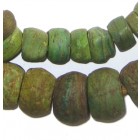

Green Hebron Beads
Hebron Beads (sometimes referred to as Kano Beads) are a form of glass Trade Bead which originate from the Holy city of Hebron in Palestine. The city is rather better known as the final resting place of the patriarchs and matriarchs of the Jewish, Muslim and Christian faiths, however, also has a long and fascinating history of glass-making which dates back to 63 BCE. These early glass beads were blown spheres of round glass, simply decorated with evil eye designs to ward off malevolent spirits. Hebron Beads are typically donut-shaped with a far courser finish.
The earliest known beads produced in Hebron for trade were manufactured during the 18th Century. British explorer William George Brown references two different sizes of bead – Hershe and Munjir – produced in the region in his journal of 1799, with further observations detailing their course texture and rustic finish. Their eroded aesthetic derives from the fact that they are made with salts from the Dead Sea, and sand from the outlying village of Bani Na’im.
As trade networks developed between Africa, Palestine and Egypt in the early 1800s, Hebron’s glass-makers began producing beads exclusively for trade in foreign lands. They were particularly well received by the Igbo and Yoruba tribes of Kano, Nigeria, both of whom consider large, heavy beads to be indicative of wealth and social status. The Yoruba, however, noticed that the rough glass beads did not sit uniformly when strung upon a raffia, and so ground down the sides of the beads themselves using flattened stones. Early historians were originally of the impression the beads were produced by the Yoruba – hence the name “Kano Beads”.